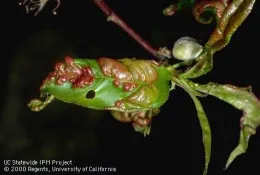
The peach leaf curl fungus is spread by tiny spores which are produced on infected leaves and blown about by wind. As leaves begin to emerge in the spring, the spores are washed onto them, and infection begins. If the weather remains cool and wet, young leaves will be continually infected. Throughout the winter, while the tree is dormant, the spores lie exposed on limbs, twigs and buds. It is during this period that the disease can be controlled with fungicide sprays. In the dry, hot weather of late spring and early summer, the disease stops spreading.
Spraying now during the dormant season helps prevent peach leaf curl in spring. Several products are generally effective in controlling peach leaf curl and are readily available at nurseries and garden stores. These include products containing basic copper sulfate. Make sure to do a thorough job of covering every bit of the tree with the spray.
Ed Perry is the emeritus Environmental Horticultural Advisor for University of California Cooperative Extension (UCCE) in Stanislaus County where he worked for over 30 years.

